I've been doing all sorts of jobs around the house today, and I've never changed out of my pajamas. So let's find out about pajamas.

Pajamas rock.
(Photo from Sodahead)
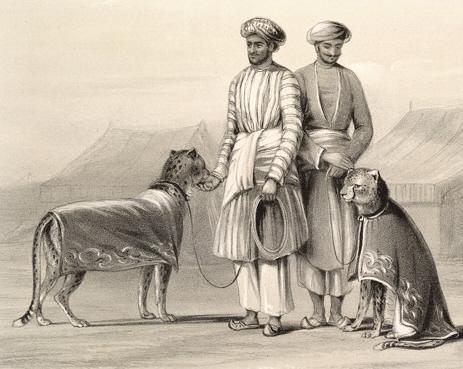
Men from India wearing their pajamas. Not for sleeping or lounging, but actually to go cheetah hunting. You can't see how they fasten, of course, but you can see how loose and floppy they are at the ankles.
(Photo from Wikimedia Commons)
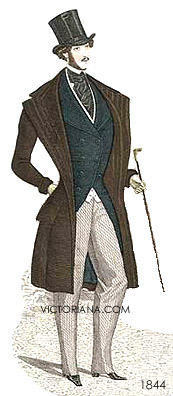
Meanwhile, back in England, here's what the men were wearing in 1844. Not exactly loose and flowing and floppy.
(Photo, as you can see, from Victoriana.com)
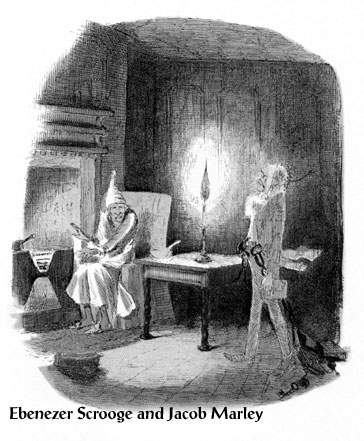
Here's Scrooge wearing his nightshirt and cap when Jacob Marley pays his portentous visit.
(From A Christmas Carol, from Bygone Books Blog)

This is a strange hodgepodge of stuff for sale in an antique store, but that white garment is a man's nightshirt. Topping it off is a top hat decorated for Christmas, so you'll have to imagine the nightshirt without the hat. Looks an awful lot like a nightgown, doesn't it?
(Photo from Musings of a Sea Witch)

Footed pajamas are now so pervasive, I bet most of you reading this blog wore them at some point in your early childhood. They're also apparently all the rage on college campuses these days.
(Photo from Ur College Fashion)
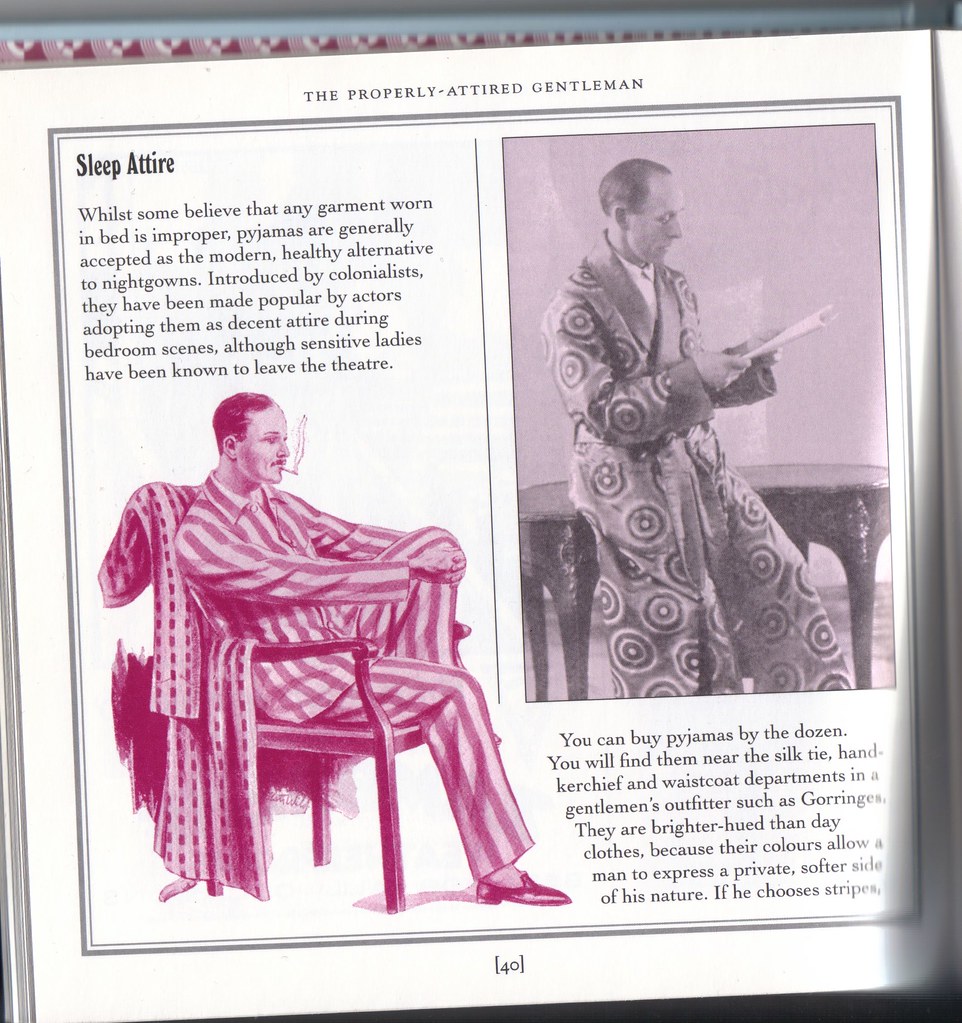
I'm not sure where or when this ad originally ran, but I'm going to guess in England, some time in the 1930s. The copy is especially delightful.
(Photo from Dumbbells, Ear Caps, and Hair Restorers: A Shopper's Guide to Gentleman's Foibles -- 1800s-1930s. From The Steampunk Forum at Brass Goggles)
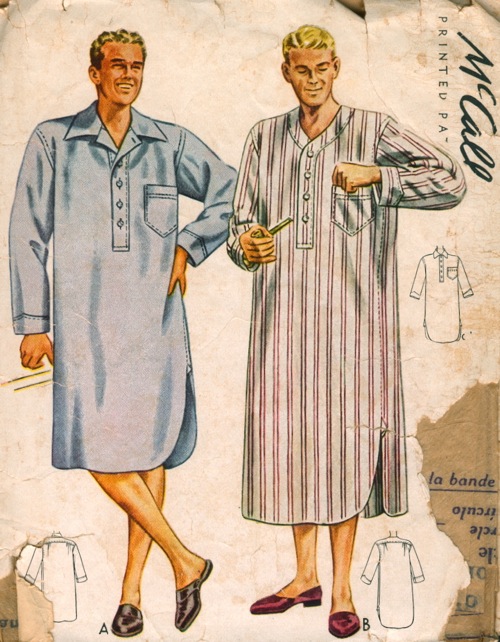
Nightshirts didn't entirely go away at first. This McCall's pattern for a man's nightshirt is from 1941.
(Image from Vintage Patterns Wiki)
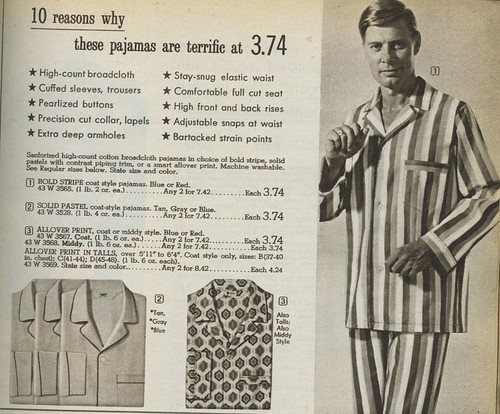
But by 1966, which is when this ad is from, the nightshirt was pretty much gone and it was all pajamas. And at $3.74, how can you go wrong?
(Photo from 1966 Spiegel catalog from genibee on Flickr)

There's tons of variety in women's pajamas now. You've got your long pants/long sleeved fleeces, your long pants/T-shirt cottons, your fancy silks, your shorty top and bottoms, and everything else in between.
(Photo from Diva Village, where you can buy any or all of these)

I don't know who would do such a thing as this.
(Image from Leslie Linevsky on E-Marketing)

This is the proper way to wear footy pajamas.
(Photo from ParentLife Online)
Sources
Online Etymology Dictionary, Pajamas
Sir Henry Yule and Arthur Coke-Burnell, Hobson-Jobson: A glossary of colloquial Anglo-Indian words and phrases, and of kindred terms, etymological, historical, geographical, and discursive, 1903, page 748, PYJAMMAS.
Ask Andy About Clothes, Pajamas - History of
JumpinJammerz.com, History of Pajamas
Manas: India and its Neighbors, History and Politics, British India

Pajamas rock.
(Photo from Sodahead)
- The word "pajama" (in England, "pyjama") is actually a Hindi word, pajama. That word derives from the Persian (Iran used to be Persia) paejamah or paijama. The word means "leg clothing."
- The word comes straight from that part of the world because that's where the garment came from.
- In the 1700s when the British first showed up in India, they thought the loose, baggy trousers that people wore were a pretty good idea. Muslims, both men and women, wore them, and some Sikh men did too. "By Jove," thought the British, "cracking good idea, especially in this heat."

Men from India wearing their pajamas. Not for sleeping or lounging, but actually to go cheetah hunting. You can't see how they fasten, of course, but you can see how loose and floppy they are at the ankles.
(Photo from Wikimedia Commons)

Meanwhile, back in England, here's what the men were wearing in 1844. Not exactly loose and flowing and floppy.
(Photo, as you can see, from Victoriana.com)
- So the British brought the pajamas back to England with them. But what with the damp and cold weather and more restrictive clothing styles, they didn't really catch on for everyday wear. Some British men wore them for lounging around the house, but after a while even that fell out of fashion.
- In the 1800s as the British were securing more and more of India under their control, they thought, "Dash it, those pajamas are capital garments." So they brought them back home with them again. This round of British pajama-lovers wore them at night, for sleeping.
- This was still rather an exotic idea in England at the time. While women wore nightdresses, most men slept naked, or they wore long nightshirts and caps.

Here's Scrooge wearing his nightshirt and cap when Jacob Marley pays his portentous visit.
(From A Christmas Carol, from Bygone Books Blog)

This is a strange hodgepodge of stuff for sale in an antique store, but that white garment is a man's nightshirt. Topping it off is a top hat decorated for Christmas, so you'll have to imagine the nightshirt without the hat. Looks an awful lot like a nightgown, doesn't it?
(Photo from Musings of a Sea Witch)
- I should note that while the idea of wearing pants to bed was all new in England, it was not new to the Portuguese. Or at least, those who lived on the island of Goa. A French traveler noted that the Portuguese there had adopted the custom of wearing loose cotton pants to bed as early as 1610. But apparently the French traveler didn't think much of it, nor did many other Europeans because most histories maintain that European men didn't wear pants to bed until the mid-1800s.
- As my history teacher used to say, quoting Victor Hugo, "There is nothing more powerful than an idea whose time has come." Apparently by the mid-1800s the time for pajamas in England had come because they soon became quite popular as sleeping garments.
- They only caught on with the men-folk, though. I don't know if that's because the women already had a sleeping garment, the nightdress, or if it was mainly the men who were soldiering in India who had encountered pajamas in their native habitat so to speak, and so were already comfortable with the idea of wearing them. Whatever the reason, it was the men who wore pajamas to bed.
- Some time not too long after that, the footed pajama was born. It's thought that someone first sewed feet/socks to the bottom of pajamas to protect the feet from bugs. Specifically, termites, which were very common in India.

Footed pajamas are now so pervasive, I bet most of you reading this blog wore them at some point in your early childhood. They're also apparently all the rage on college campuses these days.
(Photo from Ur College Fashion)
- In The Secret Sharer (1910) by Joseph Conrad, the narrator says he was in his "sleeping suit," a phrase I always liked. I wonder if that was pajamas, or a nightshirt and cap, or what.
- It took a little longer, but by 1923 or 1924, American fashion magazines were reporting that the high society men and women both had been seen wearing pajamas at the beach. Well, once it was known that the well-to-do were wearing their pajamas in public, the general public had to have pajamas too, and pajama sales took off.
- Clothing retailers reported that, though they were selling lots of pajamas, they were still selling just as many nightgowns as before. Presumably this mean that women wearing pajamas at that time were mainly wearing them in public but still preferred the good old nightgown for sleeping.

I'm not sure where or when this ad originally ran, but I'm going to guess in England, some time in the 1930s. The copy is especially delightful.
(Photo from Dumbbells, Ear Caps, and Hair Restorers: A Shopper's Guide to Gentleman's Foibles -- 1800s-1930s. From The Steampunk Forum at Brass Goggles)

Nightshirts didn't entirely go away at first. This McCall's pattern for a man's nightshirt is from 1941.
(Image from Vintage Patterns Wiki)

But by 1966, which is when this ad is from, the nightshirt was pretty much gone and it was all pajamas. And at $3.74, how can you go wrong?
(Photo from 1966 Spiegel catalog from genibee on Flickr)
- Since the word "pajama" actually means "clothes you wear on your legs," it's technically redundant to say "pajama pants." But now, since we buy and sell a set of clothes with a shirt and pants and we call the whole set "pajamas," the phrase "pajama pants" has come into being as a way to specify one item of the set.

There's tons of variety in women's pajamas now. You've got your long pants/long sleeved fleeces, your long pants/T-shirt cottons, your fancy silks, your shorty top and bottoms, and everything else in between.
(Photo from Diva Village, where you can buy any or all of these)

I don't know who would do such a thing as this.
(Image from Leslie Linevsky on E-Marketing)

This is the proper way to wear footy pajamas.
(Photo from ParentLife Online)
Sources
Online Etymology Dictionary, Pajamas
Sir Henry Yule and Arthur Coke-Burnell, Hobson-Jobson: A glossary of colloquial Anglo-Indian words and phrases, and of kindred terms, etymological, historical, geographical, and discursive, 1903, page 748, PYJAMMAS.
Ask Andy About Clothes, Pajamas - History of
JumpinJammerz.com, History of Pajamas
Manas: India and its Neighbors, History and Politics, British India
an interesting fact about the word pajama is , that pai which means foot in India and the French word for foot pied have a common ancestor.There are many sanskrit and Latin (IndoLatin) words have common roots
ReplyDelete